CHEVROLET BLAZER 1995 2.G Manual PDF
Manufacturer: CHEVROLET, Model Year: 1995, Model line: BLAZER, Model: CHEVROLET BLAZER 1995 2.GPages: 380, PDF Size: 20.04 MB
Page 71 of 380
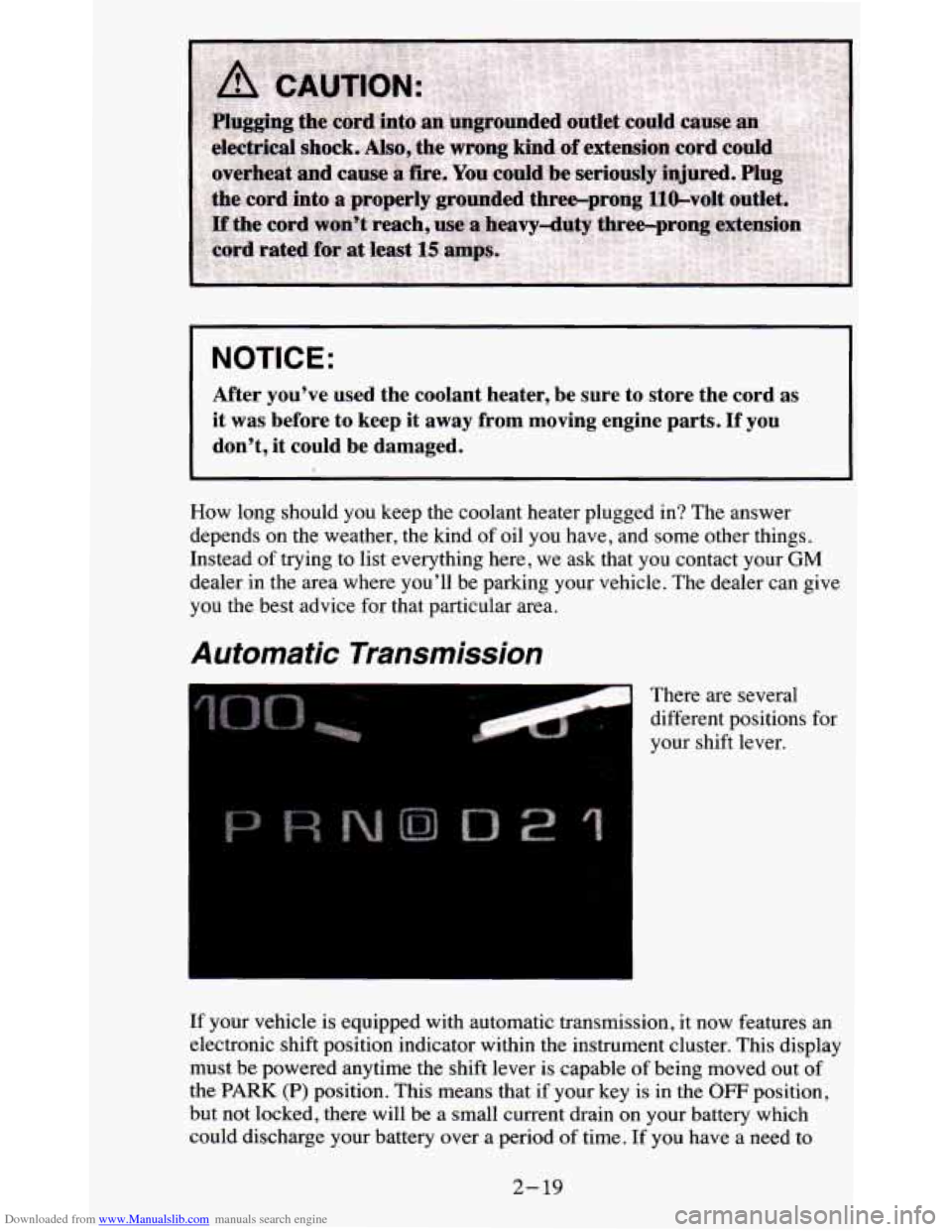
Downloaded from www.Manualslib.com manuals search engine NOTICE:
After you’ve used the coolant heater, be sure to store the \
cord as
it was before to keep it away from moving engine parts. If you
don’t, it could be damaged.
How long should you keep the coolant heater plugged in? The answer
depends on the weather, the kind of oil you have, and some other things.
Instead of trying to list everything here, we ask that you contact your
GM
dealer in the area where you’ll be parking your vehicle. The dealer can give
you the best advice for that particular area.
Automatic Transmission
c There are several
different positions for
your shift lever.
If your vehicle is equipped with automatic transmission, it now features an
electronic shift position indicator within the instrument cluster. This display
must be powered anytime the shift lever is capable of being moved out of
the
PARK (P) position. This means that if your key is in the OFF position,
but not locked, there will be a small current drain on your battery which
could discharge your battery over a period of time. If
you have a need to
2- 19
Page 72 of 380
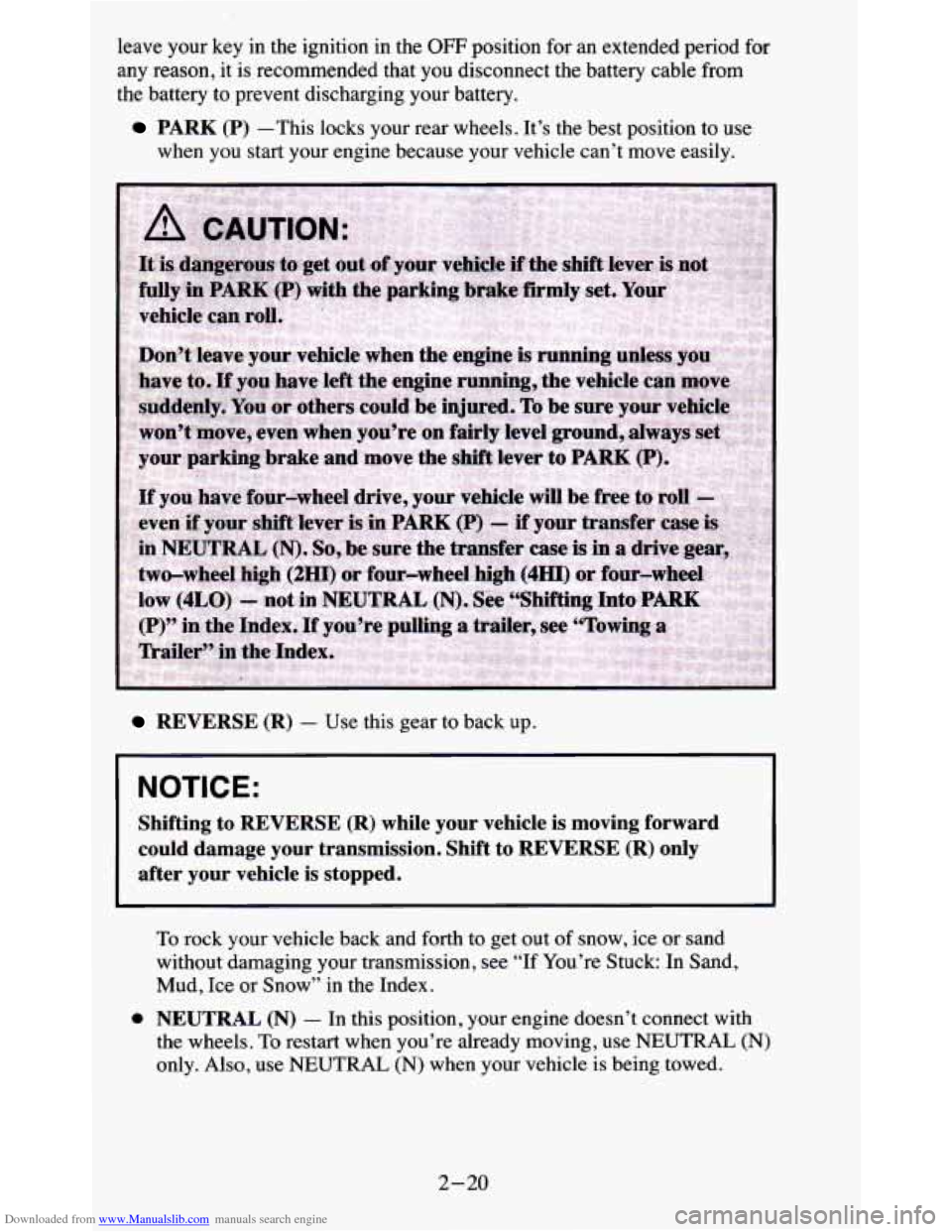
Downloaded from www.Manualslib.com manuals search engine leave your key in the ignition in the OFF position for an extended period for
any reason, it is recommended that you disconnect the battery cable from
the battery
to prevent discharging your battery.
PARK (P) -This locks your rear wheels. It’s the best position to use
when you start your engine because your vehicle can’t move easily.
REVERSE (R) - Use this gear to back up.
NOTICE:
Shifting to REVERSE (R) while your vehicle is moving forward
could damage your transmission. Shift to REVERSE
(R) only
after your vehicle is stopped.
e
To rock your vehicle back and forth to get out of snow, ice or sand
without damaging your transmission, see “If You’re Stuck:
In Sand,
Mud, Ice or Snow’’
in the Index.
NEUTRAL (N) - In this position, your engine doesn’t connect with
the wheels. To restart when you’re already moving, use
NEUTRAL (N)
only. Also, use NEUTRAL (N) when your vehicle is being towed.
2-20
Page 73 of 380
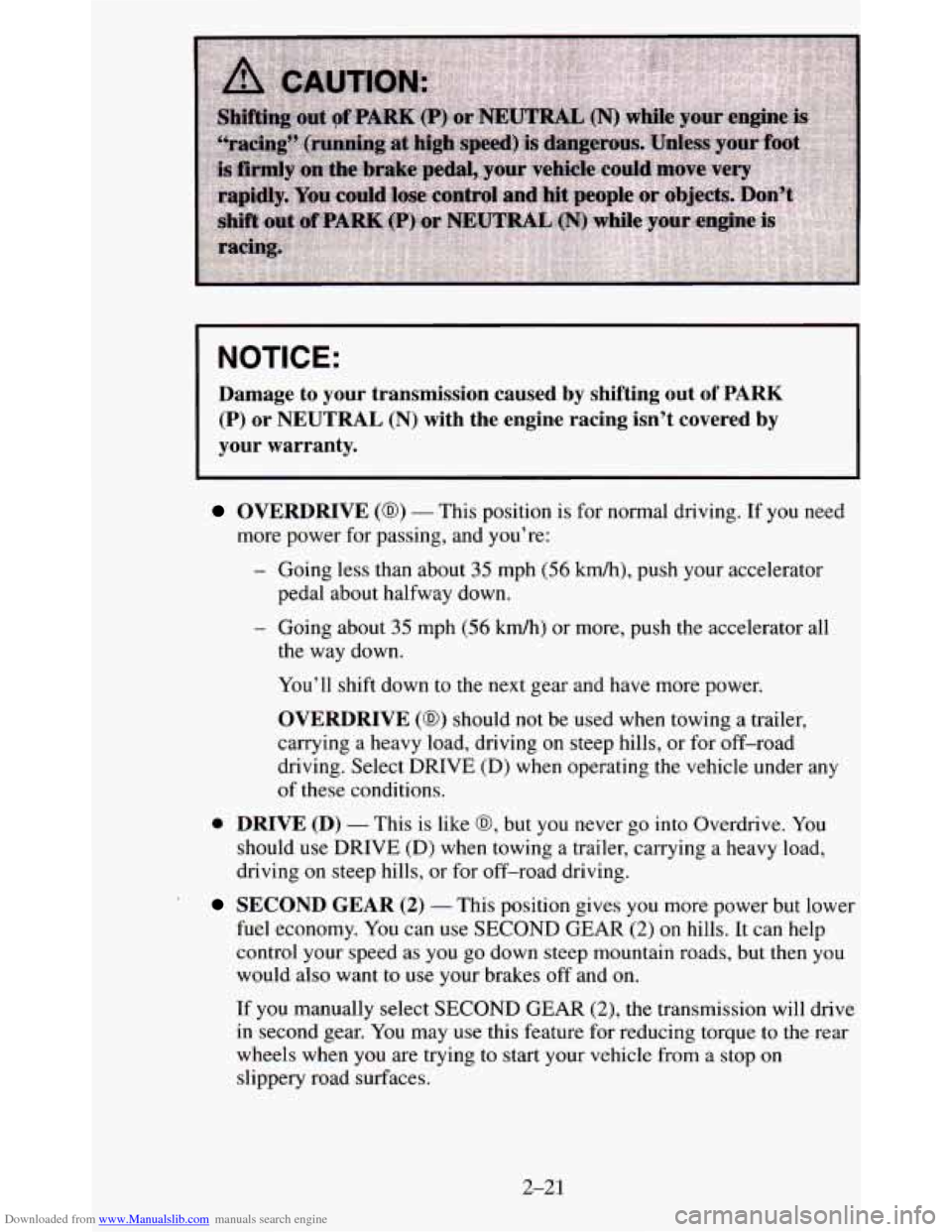
Downloaded from www.Manualslib.com manuals search engine NOTICE:
Damage to your transmission caused by shifting out of PARK
(P) or
NEUTRAL (N) with the engine racing isn’t covered by
your warranty.
OVERDRIVE (0) - This position is for normal driving. If you need
more power for passing, and you’re:
pedal about halfway down.
- Going less than about 35 mph (56 km/h), push your accelerator
- Going about 35 mph (56 kdh) or more, push the accelerator all
the way down.
You’ll shift down
to the next gear and have more power.
OVERDRIVE (a) should not be used when towing a trailer,
carrying
a heavy load, driving on steep hills, or for off-road
driving. Select
DRIVE (D) when operating the vehicle under any
of these conditions.
0 DRIVE (D) - This is like @, but you never go into Overdrive. You
should
use DRIVE (D) when towing a trailer, carrying a heavy load,
driving on steep
hills, or for off-road driving.
SECOND GEAR (2) - This position gives you more power but lower
fuel economy. You
can use SECOND GEAR (2) on hills. It can help
control your speed as you
go down steep mountain roads, but then you
would also want to use your brakes off and on.
If you manually select
SECOND GEAR (2), the transmission will drive
in second gear. You may use this feature for reducing torque to the rear
wheels when
you are trying to start your vehicle from a stop on
slippery road surfaces.
2-21
Page 74 of 380

Downloaded from www.Manualslib.com manuals search engine FIRST GEAR (1) - This position gives you even more power (but
lower fuel economy) than SECOND GEAR (2).
You can use it on very
steep hills,
or in deep snow or mud. If the selector lever is put in FIRST
GEAR
(1) while the vehicle is moving forward, the transmission won’t
shift into FIRST GEAR
(1) until the vehicle is going slowly enough.
NOTICE:
If your rear wheels can’t rotate, don’t try to drive. This might
happen
if you were stuck in very deep sand or mud or were up
against a solid object. You could damage your transmission.
Also,
if you stop when going uphill, don’t hold your vehicle there
with only the accelerator pedal. This could overheat and damage
the transmission. Use your brakes or shift into
PARK (P) to hold
your vehicle in position on a hill.
Five-Speed Manual Transmission
.- I
This is your shift
pattern. Here’s how
to
operate your
transmission:
FIRST GEAR (1) - Press the clutch pedal and shift into FlRST GEAR (1).
Then, slowly let up on the clutch pedal as you press the accelerator pedal.
You can shift into FIRST GEAR (1) when you’re going less than 20 mph
(32
km/h). If you’ve come to a complete stop and it’s hard to shift into
FIRST GEAR (1)’ put the shift lever in NEUTRAL, (N) and let up on the
clutch. Press the clutch pedal back down. Then shift into FIRST GEAR (1).
2-22
Page 75 of 380
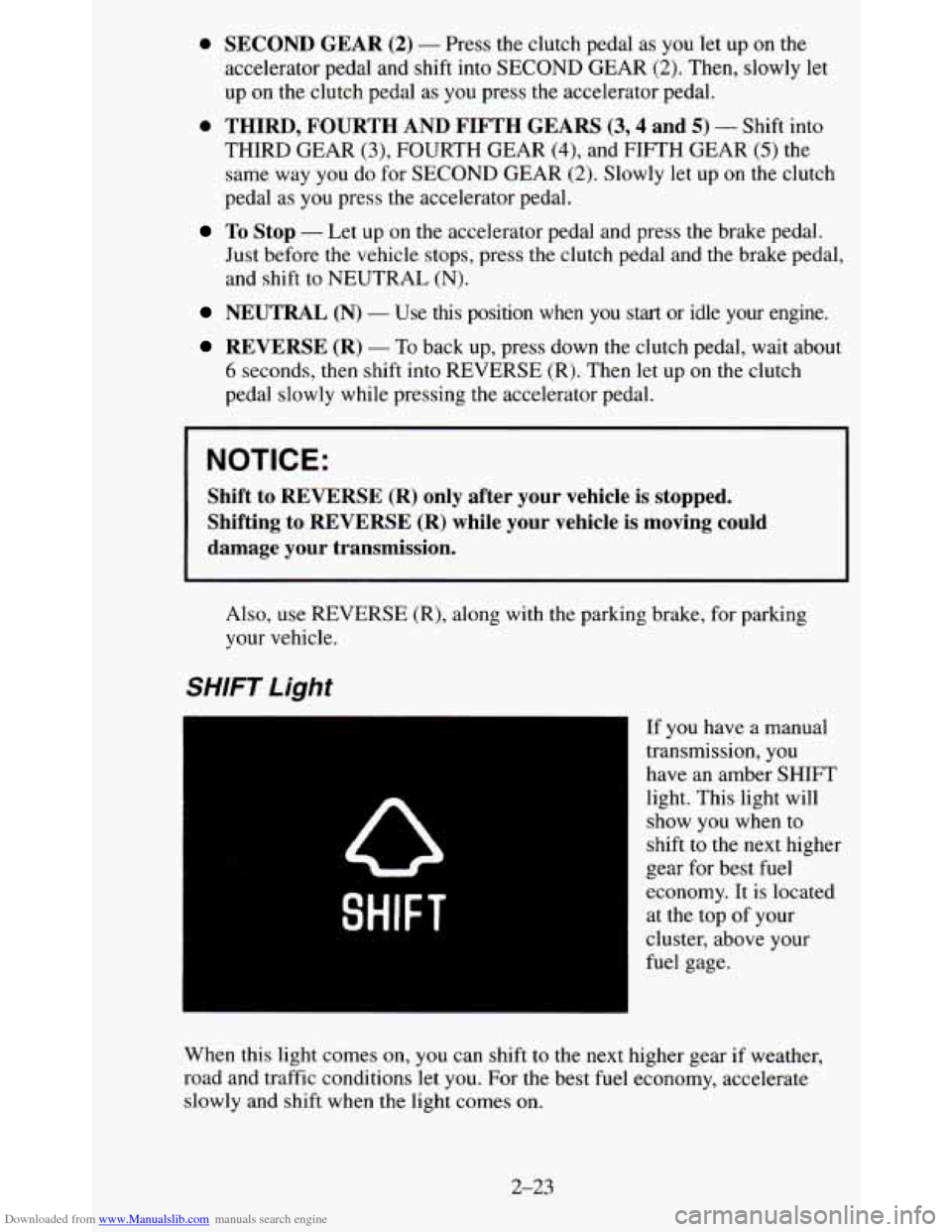
Downloaded from www.Manualslib.com manuals search engine 0 SECOND GEAR (2) - Press the clutch pedal as you let up on the
accelerator pedal and shift into SECOND GEAR
(2). Then, slowly let
up on
the clutch pedal as you press the accelerator pedal.
0 THIRD, FOURTH AND FIFTH GEARS (3,4 and 5) - Shift into
THIRD GEAR
(3), FOURTH GEAR (4), and FIFTH GEAR (5) the
same way you do for SECOND GEAR
(2). Slowly let up on the clutch
pedal as
you press the accelerator pedal.
Just before the vehicle stops, press the clutch pedal
and the brake pedal,
and shift to
NEUTRAL (N).
To Stop - Let up on the accelerator pedal and press the brake pedal.
NEUTRAL (N) - Use this position when you start or idle your engine.
REVERSE (R) - To back up, press down the clutch pedal, wait about
6 seconds, then shift into REVERSE (R). Then let up on the clutch
pedal slowly while pressing
the accelerator pedal.
NOTICE:
Shift to REVERSE (R) only after your vehicle is stopped.
Shifting to REVERSE (R) while your vehicle is moving could
damage your transmission.
Also, use REVERSE (R), along with the parking brake, for parking
your vehicle.
SHIFT Light
SHIFT
If you have a manual
transmission, you
have an amber SHIFT
light. This light will
show you when to
shift to the next higher
gear for best fuel
economy. It is located
at the top of your
cluster, above your
fuel gage.
When this light comes on,
you can shift to the next higher gear if weather,
road and traffic conditions let you. For the best fuel economy, accelerate
slowly and shift when the light comes
on.
2-23
Page 76 of 380
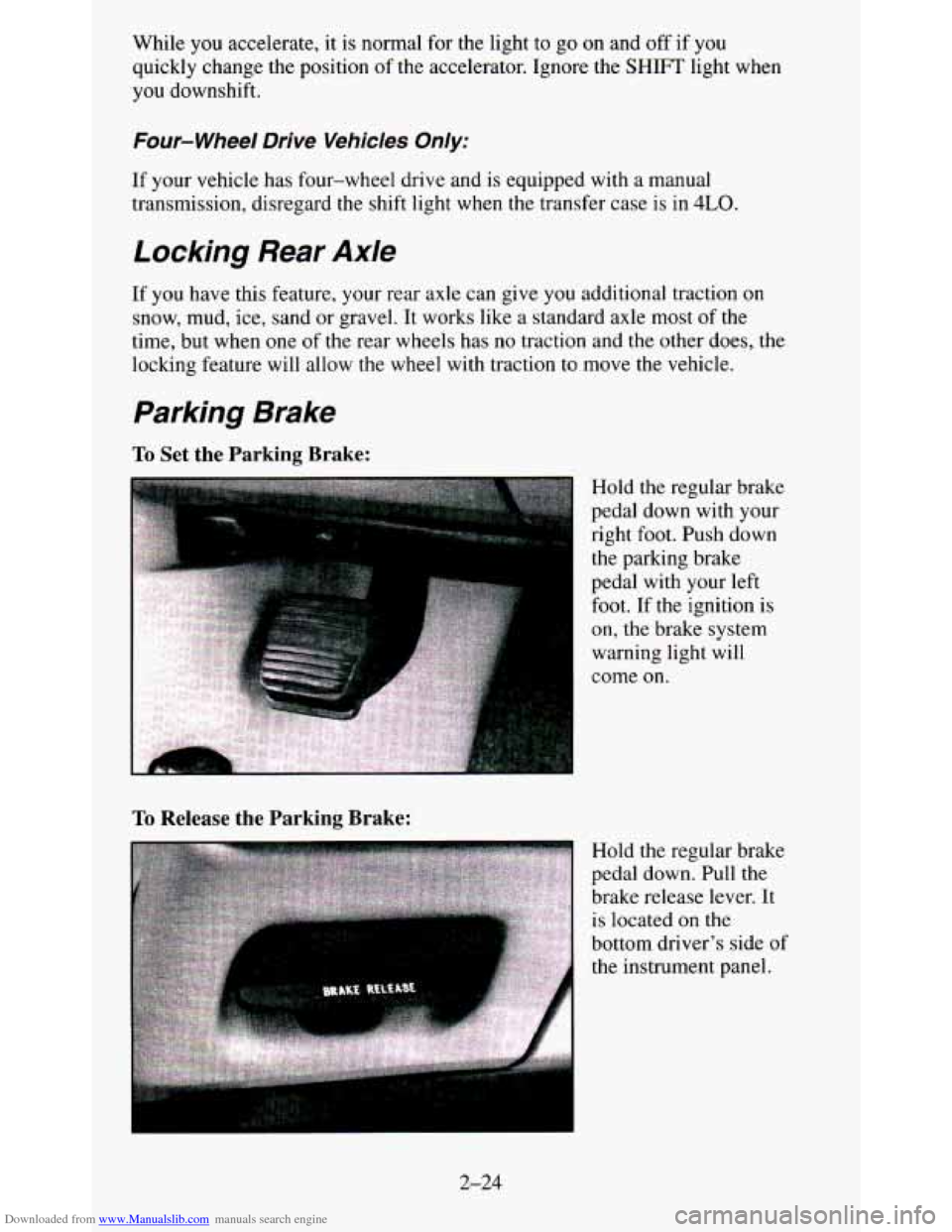
Downloaded from www.Manualslib.com manuals search engine While you accelerate, it is normal for the light to go on and off if you
quickly change the position of the accelerator. Ignore the SHIFT light when
you downshift.
Four- Wheel Drive Vehicles Only:
If your vehicle has four-wheel drive and is equipped with a manual
transmission, disregard the shift light when the transfer case is in
4LO.
Locking Rear Axle
If you have this feature, your rear axle can give you additional traction on
snow, mud, ice, sand or gravel. It works like a standard axle most
of the
time, but when one
of the rear wheels has no traction and the other does, the
locking feature will allow
the wheel with traction to move the vehicle.
Parking Brake
To Set the Parking Brake:
To Release the Parking Brake:
Hold the regular brake
pedal down with your
right
foot. Push down
the parking brake
pedal with your left
foot. If the ignition is
on, the brake system
warning light will
come
on.
Hold the regular brake
pedal down. Pull the
brake release lever. It
is located
on the
bottom driver's side
of
the instrument panel.
2-24
Page 77 of 380
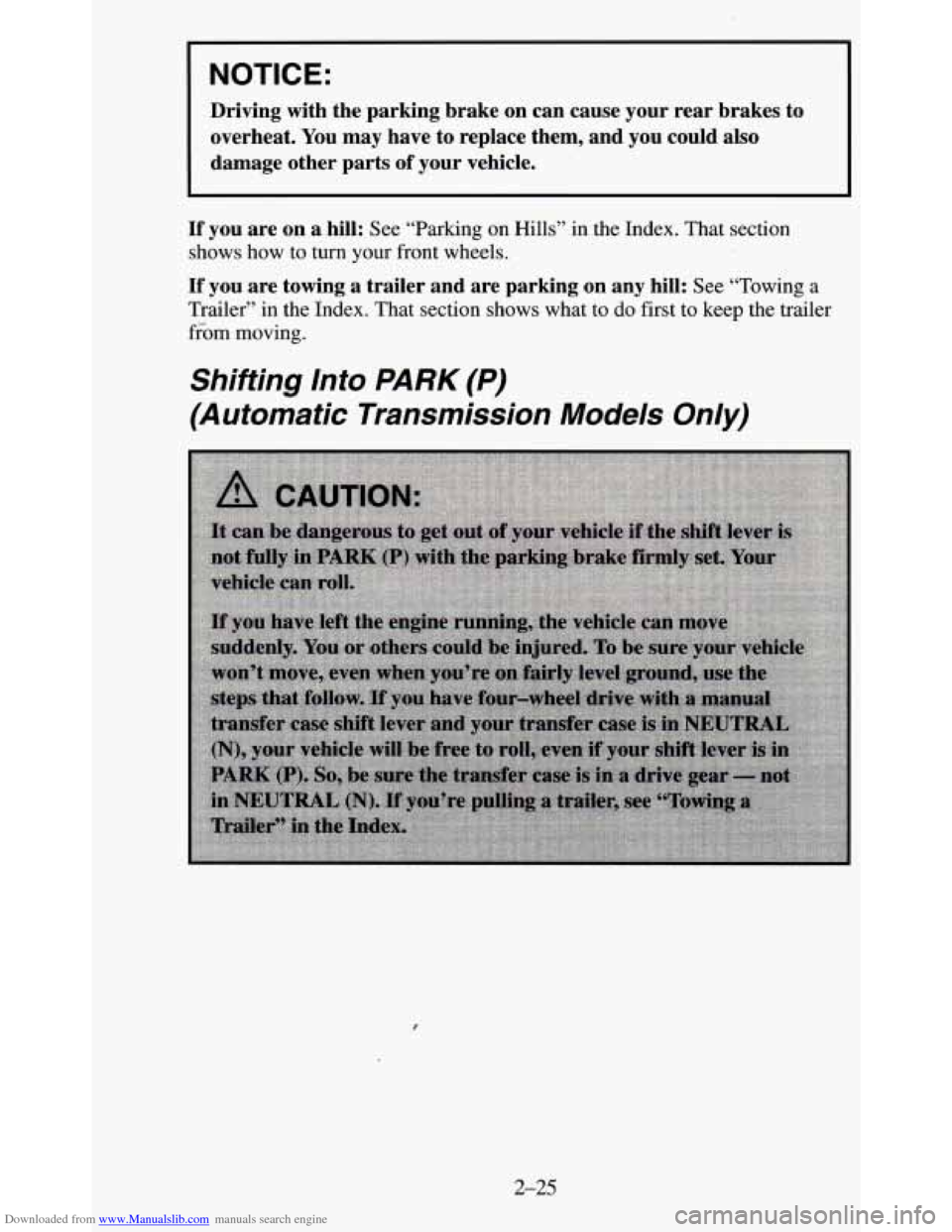
Downloaded from www.Manualslib.com manuals search engine r
~~ ~
NOTICE: I
Driving with the parking brake on can cause your rear brakes \
to overheat. You may have to replace them, and you could also
damage other parts
of your vehicle.
If you are on a hill: See “Parking on Hills” in the Index. That section
shows how to turn your front wheels.
If you are towing a trailer and are parking on any hill: See “Towing a
Trailer” in the Index. That section shows what to
do first to keep the trailer
ffom moving.
Shifting Into PARK (P)
(Automatic Transmission
Models Only)
2-25
Page 78 of 380
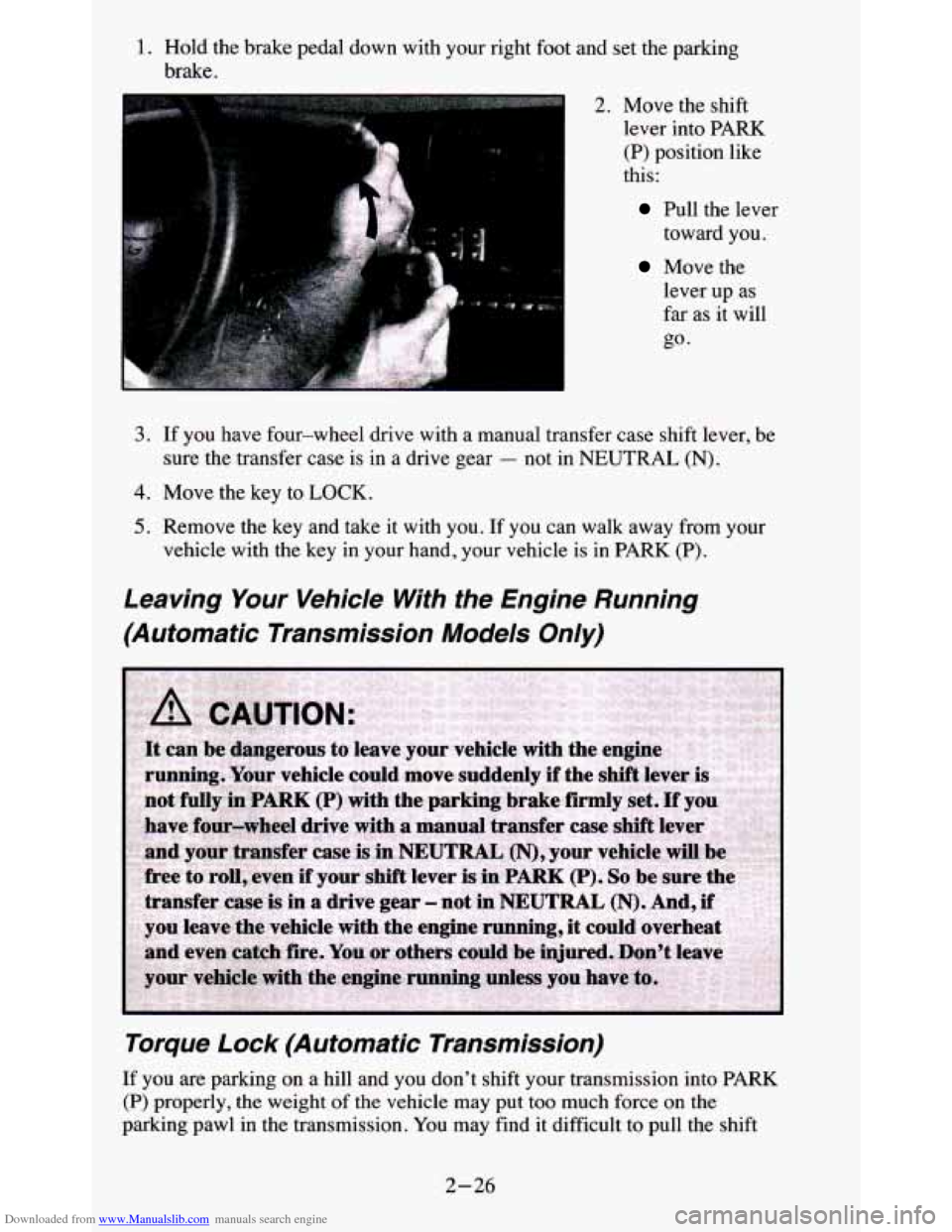
Downloaded from www.Manualslib.com manuals search engine 1. Hold the brake pedal down with your right foot and set the p\
arking
brake.
2. Move the shift lever into
PARK
(P) position like
this:
Pull the lever
toward you.
Move the
lever up as
far as it will
go.
3. If you have four-wheel drive with a manual transfer case shift lever, be
sure the transfer case is in a drive gear
- not in NEUTRAL (N).
4. Move the key to LOCK.
5. Remove the key and take it with you. If you can walk away from your
vehicle with the
key in your hand, your vehicle is in PARK (P).
Leaving Your Vehicle With the Engine Running
(Automatic Transmission Models Only)
Torque Lock (Automatic Transmission)
If you are parking on a hill and you don’t shift your transmission into PARK
(P) properly, the weight of the vehicle may put too much force on the
parking pawl in the transmission. You may find it difficult to pull the shift
2-26
Page 79 of 380
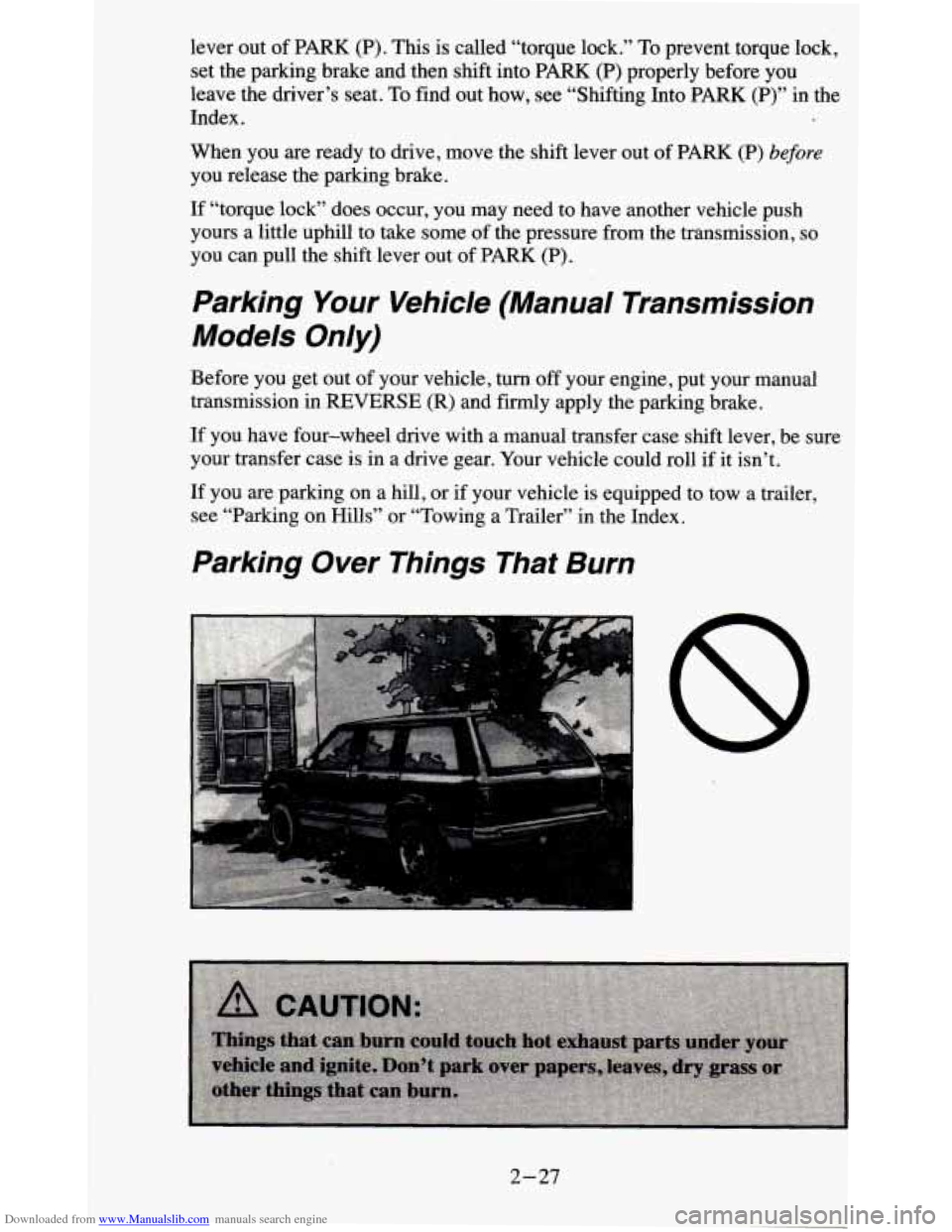
Downloaded from www.Manualslib.com manuals search engine lever out of PARK (P). This is called “torque lock.” To prevent torque lock,
set the parking brake and then shift into
PARK (P) properly before you
leave the driver’s seat.
To find out how, see “Shifting Into PARK (P)” in the
Index.
When you are ready to
drive, move the shift lever out of PARK (P) before
you release the parking brake.
If “torque lock” does occur, you may need to have another vehicle push
yours a little uphill to take some of the pressure from the transmission,
so
you can pull the shift lever out of PARK (P).
Parking Your Vehicle (Manual Transmission
Models Only)
Before you get out of your vehicle, turn off your engine, put your manual
transmission in
REVERSE (R) and firmly apply the parking brake.
If you have four-wheel drive with a manual transfer case shift lever, be sure
your transfer case is in a drive gear. Your vehicle could roll
if it isn’t.
If you are parking on a hill, or if your vehicle is equipped to tow a trailer,
see “Parking on Hills” or “Towing a Trailer” in the Index.
Parking Over Things That Burn
2-27
Page 80 of 380
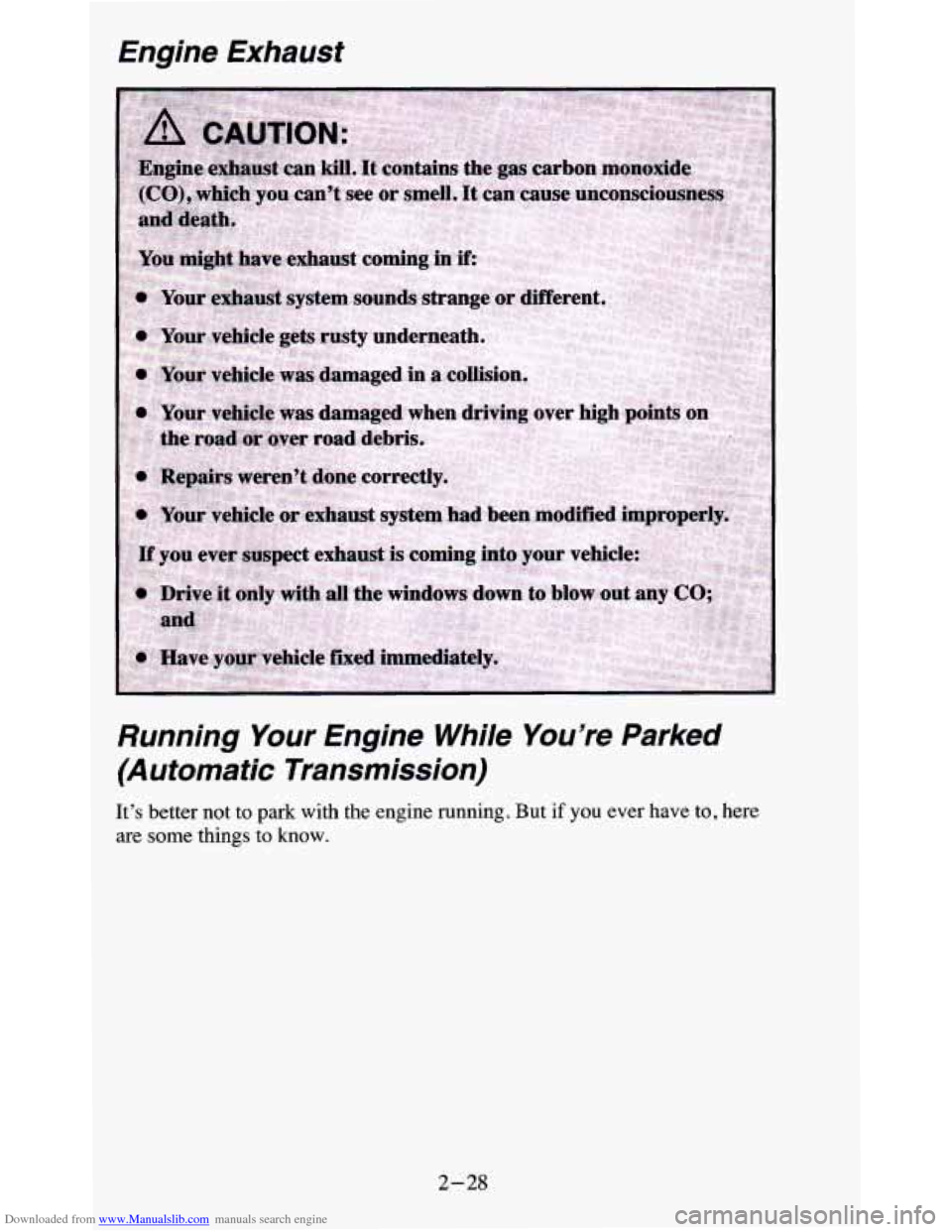
Downloaded from www.Manualslib.com manuals search engine Engine Exhaust
Running Your Engine While You’re
Parked
(Automatic Transmission)
It’s better not to park with the engine running. But if you ever have to, here
are some things to know.
2-28